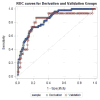Prehospital recognition of severe sepsis: development and validation of a novel EMS screening tool
- PMID: 26070235
- PMCID: PMC4562872
- DOI: 10.1016/j.ajem.2015.04.024
Prehospital recognition of severe sepsis: development and validation of a novel EMS screening tool
Abstract
Objective: To derive and validate a predictive model and novel emergency medical services (EMS) screening tool for severe sepsis (SS).
Design: Retrospective cohort study.
Setting: A single EMS system and an urban, public hospital.
Patients: Sequential adult, nontrauma, nonarrest, at-risk, EMS-transported patients between January 1, 2011, and December 31, 2012 were included in the study. At-risk patients were defined as having all 3 of the following criteria present in the EMS setting: (1) heart rate greater than 90 beats/min, (2) respiratory rate greater than 20 beats/min, and (3) systolic blood pressure less than 110 mm Hg.
Interventions: None.
Measurements and main results: Among 66,439 EMS encounters, 555 met the criteria for analysis. Fourteen percent (n = 75) of patients had SS, of which 19% (n = 14) were identified by EMS clinical judgment. In-hospital mortality for patients with SS was 31% (n = 23). Six EMS characteristics were found to be predictors of SS: older age, transport from nursing home, Emergency Medical Dispatch (EMD) 9-1-1 chief concern category of "sick person," hot tactile temperature assessment, low systolic blood pressure, and low oxygen saturation. The final predictive model showed good discrimination in derivation and validation subgroups (areas under curves, 0.843 and 0.820, respectively). Sensitivity of the final model was 91% in the derivation group and 78% in the validation group. At a predefined threshold of 2 or more points, prehospital severe sepsis (PRESS) score sensitivity was 86%.
Conclusions: The PRESS score is a novel EMS screening tool for SS that demonstrates a sensitivity of 86% and a specificity of 47%. Additional validation is needed before this tool can be recommended for widespread clinical use.
Copyright © 2015 Elsevier Inc. All rights reserved.
Figures



References
-
- Dellinger RP, et al. Surviving sepsis campaign: international guidelines for management of severe sepsis and septic shock: 2012. Crit Care Med. 2013;41(2):580–637. - PubMed
-
- Martin GS, et al. The epidemiology of sepsis in the United States from 1979 through 2000. N Engl J Med. 2003;348(16):1546–54. - PubMed
-
- Gaieski DF, et al. Benchmarking the incidence and mortality of severe sepsis in the United States. Crit Care Med. 2013;41(5):1167–74. - PubMed
-
- Angus DC, et al. Protocol-based care for early septic shock. N Engl J Med. 2014;371(4):386. - PubMed
Publication types
MeSH terms
Grants and funding
LinkOut - more resources
Full Text Sources
Other Literature Sources
Medical
Miscellaneous

